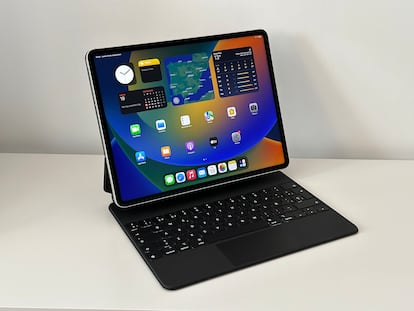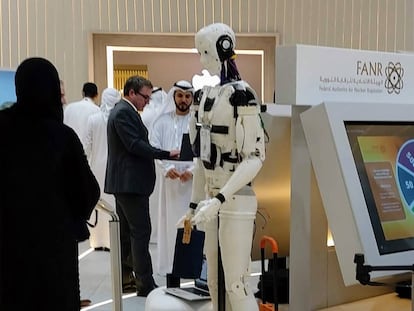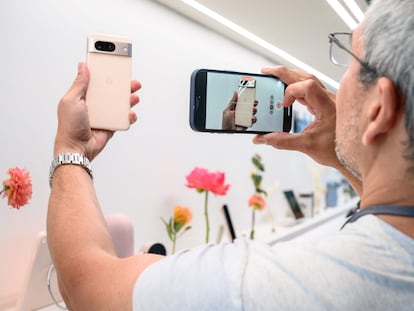I replaced my computer with a tablet and wasn’t convinced by the experience: here’s why
The most complete and modern tablets are now so powerful that, in many cases, they can easily perform the same tasks as a traditional computer. EL PAÍS tested three options with different operating systems to put this to the test

Can I replace my old computer with a tablet? This is a question that comes up quite often. Until now, my answer has always been the same: it depends on what you want to do. Yes, it may sound ambiguous, but using it to surf the Internet or watch multimedia content is not the same as using it for video editing or for work.
Indeed, this distinction is becoming increasingly blurred, and the most modern and complete tablets offer little to envy in terms of configuration to some computers. For instance, Let’s look at the 2022 iPad Pro, which has the same processor (an M2) as the latest Macbook Air and even the 13-inch Macbook Pro; or Microsoft’s Surface Pro 9, which is powered by a 12th-generation Intel Core i5 or i7, depending on the model you choose.
These are two of the three devices that I have chosen to personally test and answer the initial question of whether a computer can be replaced by a tablet for any task nowadays. The third is an Android option — the first two feature iPadOS and Windows, respectively — the Samsung Galaxy Tab S9 Plus tablet.
And I have picked them for several reasons. Firstly because of their performance, secondly because they work with different operating systems and I wanted to verify if there are differences between each one, and thirdly because they can be used in combination with keyboards and stylus without which I do not believe they would be a suitable choice for this test. However, there is a drawback: they are quite expensive products — over $1,000 —, so many users may not find it worthwhile to make the change.
iPad Pro and iPadOS
The Apple iPad Pro, in this instance in its 12.9-inch version, is pretty big for a tablet. On the one hand, this might make it a bit less comfortable to carry around (it weighs almost 700 grams); but since this is all about analyzing its performance, I have to say that I found it a pleasure to work at its screen. It’s almost like a compact laptop. For this purpose, I used the Magic Keyboard and the second-generation Apple Pencil.
In addition to the large display surface, it reproduces images very seamlessly (incorporating ProMotion technology) and in great detail, it is sharp and bright. It also responds without any delay both to the touch of the fingers and to actions with the stylus. In this case, you don’t even need to touch the screen with the stylus tip, because its pointer is floating and you just need to bring it close to the screen for this to recognize it.
You have the same feeling that everything flows when using it; no matter what task you are performing, the iPad Pro flies: high-quality video editing, photo editing, games with high graphics performance. This means that day-to-day work went smoothly, even in multitasking mode. This tablet could easily replace a laptop, with special mention of its keyboard, which is incredibly comfortable and allows you to position the screen at the angle that best suits your needs. We found one limitation (which could be important), however, which is its operating system. It runs on iPadOS, which limits the programs and applications you can use to those available in the App Store. And it is definitely not a Mac.
Surface Pro 9 with Windows
Naturally, Microsoft’s tablet runs on Windows 11 Home — and this is its greatest attraction. You can install virtually any program you wish and overall performance is extremely positive no matter what you are doing. The only limit is in the graphics, which are integrated and can only be adjusted for very specific design or editing tasks.
If we said that the iPad Pro was large and that made it difficult to carry around, in this case this feeling is even worse, as it has a 13-inch screen and weighs about 900 grams. Its aspect ratio is 3:2, which suggests that it is intended to be used for productivity-related tasks and not so much for leisure. The downside is in its autonomy, which, when tested, did not cover a full day’s work (about 6-7 hours of use).
In terms of accessories, we combined it with the Signature Keyboard, which comes with a stylus. This keyboard is characterized by its smoothness to the touch and, compared to other options, we found it to be somewhat less comfortable and noisier. In addition, its design means that the angle cannot be adjusted, which makes it less ergonomic.
Samsung Galaxy Tab S9 Plus, with Android
Most likely, if I had to recommend a tablet with the Android operating system from among the very wide range of brands and models on the market — this is the most popular and prolific option — I would opt for a model from the Korean firm. Its finishes are excellent, it provides many configuration options to adapt to different needs and its performance tends to be generally positive. Having said all that, is Android geared towards productivity-related tasks? This would be my last choice. And although the Google store is packed with thousands and thousands of apps, not all of them are optimized for use on tablets, and I don’t feel that they cover all needs. For the most basic (multimedia playback, games, word processing, some image editing, e-mail, etc.) it is more than sufficient. This review can be applied to its performance: this particular model is one of the most powerful — if not the most powerful — with the Android operating system at present. But even so, its configuration is inferior to the previous options. In this case, for instance, it is powered by a Snapdragon 8 gen 2 processor; the same as the one found in the Korean company’s Galaxy S23 smartphones.
Other than that, a 12.4-inch touchscreen offers excellent quality rivaling that of the iPad Pro or the Surface Pro 9. Its cover-keyboard (Book Cover Keyboard) is composed of two elements, one that covers the back of the device (and also serves to store the stylus) and the keyboard part. The system itself is not very comfortable, it tends to deconfigure, but the user experience during text insertion was satisfactory.
In conclusion
After several weeks of testing with only a tablet for work and other leisure-related tasks instead of my usual computer, I have come to a clear conclusion: there are currently models that allow very similar tasks to be performed in both scenarios. So the switch could be manageable. But would I permanently replace my computer? Definitely not. The size of the screen and the comparative cost between one and the other type of equipment (powerful tablets are significantly more expensive) mean that I’ll be sticking with my PC.
Sign up for our weekly newsletter to get more English-language news coverage from EL PAÍS USA Edition
Tu suscripción se está usando en otro dispositivo
¿Quieres añadir otro usuario a tu suscripción?
Si continúas leyendo en este dispositivo, no se podrá leer en el otro.
FlechaTu suscripción se está usando en otro dispositivo y solo puedes acceder a EL PAÍS desde un dispositivo a la vez.
Si quieres compartir tu cuenta, cambia tu suscripción a la modalidad Premium, así podrás añadir otro usuario. Cada uno accederá con su propia cuenta de email, lo que os permitirá personalizar vuestra experiencia en EL PAÍS.
¿Tienes una suscripción de empresa? Accede aquí para contratar más cuentas.
En el caso de no saber quién está usando tu cuenta, te recomendamos cambiar tu contraseña aquí.
Si decides continuar compartiendo tu cuenta, este mensaje se mostrará en tu dispositivo y en el de la otra persona que está usando tu cuenta de forma indefinida, afectando a tu experiencia de lectura. Puedes consultar aquí los términos y condiciones de la suscripción digital.
More information
Archived In
Últimas noticias
Aquilino Gonell, former Capitol sergeant: ‘If it hadn’t been for the police, the US would be a dictatorship’
A hybrid building: Soccer pitch, housing, and a shopping mall
Europe urges Trump to respect Greenland following annexation threats
Science seeks keys to human longevity in the genetic mixing of Brazilian supercentenarians
Most viewed
- Alain Aspect, Nobel laureate in physics: ‘Einstein was so smart that he would have had to recognize quantum entanglement’
- Mexico’s missing people crisis casts a shadow over World Cup venue
- Alvin Hellerstein, a 92-year-old judge appointed by Bill Clinton, to preside over Maduro’s trial in New York
- Why oil has been at the center of Venezuela-US conflicts for decades
- Cuba confirms death of 32 of its citizens in the US attack against Venezuela











































